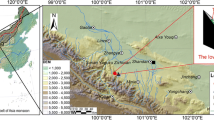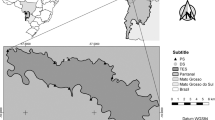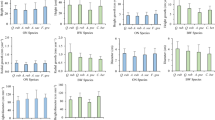Abstract
Our aim was to test whether or not climate influence the northern distributional limit of eastern white cedar (Thuja occidentalis L.) by affecting its radial growth and regeneration. Twenty-two sites were selected along the bioclimatic gradient in Northwestern Québec, Canada. The gradient was divided into three zones based on the abundance of white cedar stands: continuous, discontinuous, and marginal zones. Radial growth and regeneration (numbers of sedds, saplings) were determined for each zone. Results showed that basal area increment (b.a.i.) was the same along the gradient. Seed production and germination did not differ between zones. One-year-old seedlings and small individuals (<30 cm) were less abundant in the northern sites than in stands from the continuous and discontinuous zones. More saplings were found in the northernmost sites (389/400 m2 in the marginal and 354.7/400 m2 in the discontinuous zones) than in the south (130.6/400 m2). Layering seemed to compensate for the low recruitment observed in the marginal sites. Recruitment of seedlings originating from sexual reproduction in the discontinuous zone was not different from the stands in the southern areas. Thus, a climatically driven decrease in recruitment cannot explain the observed decrease in white cedar abundance, which occurred at this latitude. Although seedlings were less abundant in isolated northern marginal stands, sexually based regeneration was still possible. Therefore, the direct effect of climate seems to only have a minor influence on white cedar northern distributional limit and other factors, such as natural disturbances, might better explain its actual boundary.




Similar content being viewed by others
References
Asselin H, Fortin MJ, Bergeron Y (2001) Spatial distribution of late-successional coniferous species regeneration following disturbance in southwestern Quebec boreal forest. For Ecol Manag 140:29–37
Asselin H, Payette S, Fortin MJ, Vallée S (2003) The northern limit of Pinus banksiana Lamb. in Canada: explaining the difference between the eastern and the western distributions. J Biogeogr 30:1709–1718
Auger S, Payette S (2010) Four millenia of woodland structure and dynamics at the Arctic treeline of eastern Canada. Ecology 91:1367–1379
Bergeron Y, Gagnon D (1987) Age structure of red pine (Pinus resinosa) at its northern limit in Québec. Can J For Res 17:129–137
Bergeron Y, Gauthier S, Flannigan M, Kafka V (2004) Fire regimes at the transition between mixedwood and coniferous boreal forest in northwestern Quebec. Ecology 85:1916–1932
Burnham KP, Anderson DR (2002) Model selection and multimodel inference: a practical information-theoretic approach, 2nd edn. Springer, New York
Carcaillet C, Bergeron Y, Richard PJH, Frechette B, Gauthier S, Prairie YT (2001) Change of fire frequency in the eastern Canadian boreal forests during the Holocene: does vegetation composition or climate trigger the fire regime? J Ecol 89:930–946
Collier DE, Boyer MG (1989) The water relations of Thuja occidentalis L. from two sites of contrasting moisture availability. Bot Gaz 150:445–448
Cornett MW, Reich PB, Puettmann KJ (1997) Canopy feedbacks and microtopography regulate conifer seedling distribution on two Minnesota conifer-deciduous forests. Écoscience 4:353–364
Cornett MW, Reich PB, Puettmann KJ, Frelich LE (2000) Seedbed and moisture availability determine safe sites for early Thuja occidentalis (Cupressaceae) regeneration. Am J Bot 87:1807–1814
de Blois S (1994) La dynamique du thuya occidental (Thuja occidentalis L.) dans un paysage agro-forestier du Haut-Saint-Laurent, Québec. Ph.D. Thesis, Université de Montréal, Montréal, QC
Denneler B, Asselin H, Bergeron Y, Begin Y (2008) Decreased fire frequency and increased water levels affect riparian forest dynamics in southwestern boreal Quebec, Canada. Can J For Res 38:1083–1094
Diotte M, Bergeron Y (1989) Fire and the distribution of Juniperus communis L. in the boreal forest of Quebec, Canada. J Biogeogr 16:91–96
Environment Canada (2009) Canadian climate normals or averages 1971–2000. http://climate.weatheroffice.gc.ca/climate_normals/index_e.html. Accessed 4 Feb 2011
Flannigan MD, Bergeron Y (1998) Possible role of disturbance in shaping the northern distribution of Pinus resinosa. J Veg Sci 9:477–482
Flannigan MD, Woodward FI (1993) A laboratory study of the effect of temperature on red pine seed germination. For Ecol Manag 62:145–156
Hadley JL, Smith WK (1983) Influence of wind exposure on needle desiccation and mortality for timberline conifers in Wyoming, U.S.A. Arct Alp Res 15:127–135
Heinrichs DK, Tardif J, Bergeron Y (2007) Xylem production in six tree species growing on an island in the boreal forest region of western Quebec, Canada. Can J Bot 85:518–525
Huang J, Tardif JC, Bergeron Y, Denneler B, Berninger F, Girardin MP (2010) Radial growth response of four dominant boreal tree species to climate along a latitudinal gradient in the eastern Canadian boreal forest. Glob Chang Biol 16:711–731
Hulbert SH (1984) Pseudoreplication and the design of ecological field experiments. Ecol Monogr 54:187–211
Johnston WF (1990) Thuja occidentalis L. Northern White-Cedar. Silvics of North America, Vol. 1, Conifers (RM Burns, BH Honkala, Technical Co-ordinators). USDA Forest Service, Washington DC
Kjallgren L, Kullman L (1998) Spatial patterns and structure of the mountain birch tree-limit in the southern Swedish Scandes: a regional perspective. Geogr Ann Ser A Phys Geogr 80:1–16
Kullman L (2007) Tree line population monitoring of Pinus sylvestris in the Swedish Scandes, 1973–2005: implications for tree line theory and climate change ecology. J Ecol 95:41–52
Kullman L, Kjallgren L (2006) Holocene pine tree-line evolution in the Swedish Scandes: recent tree-line rise and climate change in a long-term perspective. Boreas 35:159–168
Laberge MJ, Payette S, Pitre N (2001) Development of stunted black spruce (Picea mariana) clones in the subarctic environment: a dendroarchitectural analysis. Écoscience 8:489–498
Lafleur B, Paré D, Munson AD, Bergeron Y (2010) Response of northeastern North American forests to climate change: Will soil conditions constrain tree species migration? Environ Rev 18:279–289
Liu KB (1990) Holocene paleoecology of the boreal forest and Great Lakes-St. Lawrence forest in Northern Ontario. Ecol Monogr 60:179–212
Lloyd AH, Wilson AE, Fastie CL, Landis RM (2005) Population dynamics of black spruce and white spruce near the arctic tree line in the southern Brooks Range, Alaska. Can J For Res 35:2073–2081
Matthes U, Larson DW (2006) Microsite and climatic controls of tree population dynamics: an 18-year study on cliffs. J Ecol 94:402–414
Mazerolle MJ (2006) Improving data analysis in herpetology: using Akaike’s Information Criterion (AIC) to assess the strength of biological hypotheses. Amphib Reptil 27:169–180
McKenney DW, Pedlar JH, Papadopol P, Hutchinson MF (2006) The development of 1901–2000 historical monthly climate models for Canada and the United States. Agric Forest Meteorol 138:69–81
McKenney DW, Pedlar JH, Lawrence K, Campbell K, Hutchinson MF (2007) Potential impacts of climate change on the distribution of North American trees. Bioscience 57:939–948
Meilleur A, Brisson J, Bouchard A (1997) Ecological analyses of the northernmost population of pitch pine (Pinus rigida). Can J For Res 27:1342–1350
Messaoud Y, Houle G (2006) Spatial patterns of tree seedling establishment and their relationship to environmental variables in a cold-temperate deciduous forest of eastern North America. Plant Ecol 185:319–331
Messaoud Y, Bergeron Y, Asselin H (2007) Reproductive potential of balsam fir (Abies balsamea), white spruce (Picea glauca), and black spruce (P. mariana) at the ecotone between mixedwood and coniferous forests in the boreal zone of western Quebec. Am J Bot 94:746–754
Ministère des Ressources Naturelles du Québec (MRNQ) (2010a) Données numériques écoforestières. http://www.mrn.gouv.qc.ca/forets/connaissances/connaissances-inventaire-cartes-donnees.jsp. Accessed 30 Jan 2010
Ministère des ressources naturelles du Québec (MRNQ) (2010b) Zones de végétation et domaines bioclimatiques du Québec. http://www.mrnf.gouv.qc.ca/forets/connaissances/connaissances-inventaire-zonescarte.jsp. Accessed 30 Jan 2010
Morin X, Augspurger C, Chuine I (2007) Process-based modeling of tree species’ distributions: what limits temperate tree species’ range boundaries? Ecology 88:2280–2291
Morin X, Viner D, Chuine I (2008) Tree species range shifts at a continental scale: new predictive insights from a process-based model. J Ecol 96:784–794
Musselman RC, Lester DT, Adams MS (1975) Localized ecotypes of Thuja occidentalis L. in Wisconsin. Ecology 56:647–655
Nelson TC (1951) A reproductive study of northern white cedar. Game Division, Department of Conservation, State of Michigan pp 100
Pärn H (2003) The rate of changes in the radial growth of pine trees along the latitudinal transect between 50°–70°N. Pol J Ecol 51:557–559
Paul V (2011) Les facteurs écologiques limitant la répartition nordique du thuja de l’est (Thuja occidentalis L.). Master’s Thesis, Université du Québec en Abitibi-Témiscamingue, Rouyn-Noranda, QC, Canada
Pederson N, Cook ER, Jacoby GC, Peteet DM, Griffin KL (2004) The influence of winter temperatures on the annual radial growth of six northern range margin tree species. Dendrochronologia 22:7–29
Pigott CD, Huntley JP (1981) Factors controlling the distribution of Tilia cordata at the northern limits of its geographical range. 3. Nature and causes of seed sterility. New Phytol 87:817–839
R Development Core Team (2010) R: a language and environment for statistical computing. R Foundation for Statistical Computing, Vienna, Austria. http://www.r-project.org/. Accessed 30 Jan 2010
Richard PJH (1993) The origin and postglacial dynamics of the mixed forest in Quebec. Rev Palaeobot Palynol 79:31–68
Richardson DM, Bond WJ (1991) Determinants of plant distribution: evidence from pine invasions. Am Nat 137:639–668
Sakai A, Weiser CJ (1973) Freezing resistance of trees in North Americ with refrence to tree region. Ecology 54:118–126
Simard MJ, Bergeron Y, Sirois L (2003) Substrate and litterfall effects on conifer seedling survivorship in southern boreal stands of Canada. Can J For Res 33:672–681
Sirois L (2000) Spatio-temporal variation in black spruce cone and seed crops along a boreal forest-tree line transect. Can J For Res 30:900–909
Sirois L, Begin Y, Parent J (1999) Female gametophyte and embryo development of black spruce along a shore-hinterland climatic gradient of a recently created reservoir, northern Quebec. Can J Bot 77:61–69
St. Germain JL, Krause C (2008) Latitudinal variation in tree-ring and wood cell characteristics of Picea mariana across the continuous boreal forest in Quebec. Can J For Res 38:1397–1405
Tardif JC, Bergeron Y (1997) Comparative dendrochronological analysis of two black ash and two white cedar populations from contrasting sites in the Lake Duparquet region, northwestern Quebec. Can J For Res 27:108–116
Tardif JC, Stevenson D (2001) Radial growth-climate association of Thuja occidentalis L. at the northwestern limit of its distribution, Manitoba, Canada. Dendrochronologia 19:179–187
Tremblay MF, Bergeron Y, Lalonde D, Mauffette Y (2002) The potential effects of sexual reproduction and seedling recruitment on the maintenance of red maple (Acer rubrum L.) populations at the northern limit of the species range. J Biogeogr 29:365–373
Vila B, Vennetier M, Ripert C, Chandioux O, Liang E, Guibal F, Torre F (2008) Has global change induced divergent trends in radial growth of Pinus sylvestris and Pinus halepensis at their bioclimatic limit? The example of the Sainte-Baume forest (south-east France). Ann For Sci 65:9. doi:10.1051/forest:2008048
Yagouti A, Boulet G, Vescovi L (2006) Homogénéisaiton des séries de températures du québec méridional et analyse de l'évolution du climat à l'aide d'indicateurs. Rapport No. 4 Consortium Ouranos, p 140
Acknowledgments
The authors thank Yannick Rousseau, Xavier Cavard, and Huaitong Xu for field assistance. The authors are grateful to Igor Drobyshev for his help with the dendrochronological analyses, Marc Mazerolle for statistical advice and William F. J. Parsons for careful editing of the manuscript. The authors also want to thank the Centre d’étude de la forêt (CEF), the Centre de semences forestières de Berthier, Normand Villeneuve, Claude Poulin and Renaud Dostie from the Ministère des Ressources naturelles (MRN) du Québec who found many potential sites, David Paré from the Laurentian Forestry Centre (Canadian Forest Service), and Dan McKenney from the Great Lakes Forestry Centre (Canadian Forest Service). The authors are thankful for the referees’ comments which help improved the manuscript. This project was financially supported by the Natural Sciences and Engineering Research Council of Canada (NSERC) strategic (STPGP 336871) and FRQNT (Fonds de recherche du Québec- Nature et Technologies) team grants to FT and YB.
Author information
Authors and Affiliations
Corresponding author
Additional information
Communicated by Lesley Rigg.
Appendix
Appendix
See Appendix Tables 5, 6, 7, 8 and 9.
Rights and permissions
About this article
Cite this article
Paul, V., Bergeron, Y. & Tremblay, F. Does climate control the northern range limit of eastern white cedar (Thuja occidentalis L.)?. Plant Ecol 215, 181–194 (2014). https://doi.org/10.1007/s11258-013-0288-5
Received:
Accepted:
Published:
Issue Date:
DOI: https://doi.org/10.1007/s11258-013-0288-5




